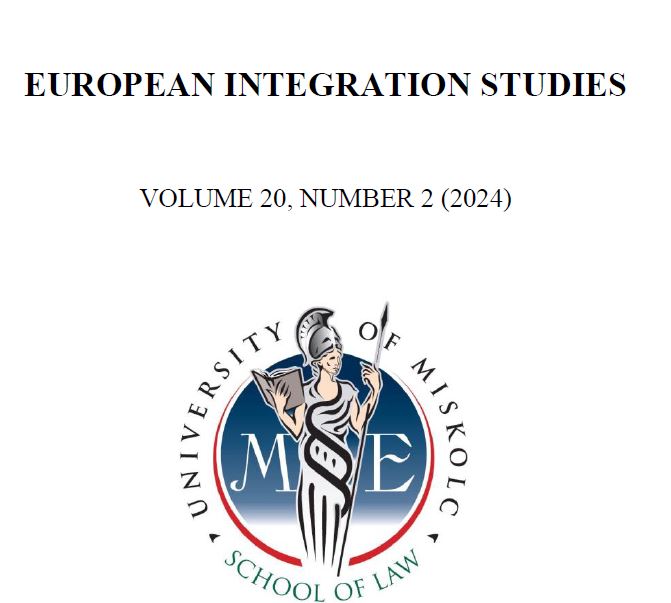Export Restrictions in the Field of Artificial Intelligence and Quantum Computing: Justification and Risks – The United States–China Rivalry from a European Union Perspective
DOI:
https://doi.org/10.46941/2024.2.17Keywords:
export controls, economic coercion, artificial intelligence, quantum information technology, United States, People’s Republic of China, European Union.Abstract
The study aims to elicit the problems posed under international law and, to a lesser extent, under European Union (EU) law by export controls imposed on foundational transformative technologies such as artificial intelligence and quantum information technology in the relations between United States and People’s Republic of China. It examines the notion of export controls and its evaluation under international law, finding that such an evaluation of the legal nature of these measures remains unclear on not only whether these measures may constitute economic coercion but also whether such coercion is prohibited. Further uncertainty persists regarding whether other legal foundations may be identified, which would permit such measures when they affect critical technologies for future development. The study finds that, currently, export controls affecting artificial intelligence and quantum information technology are limited but expanding, thereby creating some urgency in finding legal solutions to counteract their effects. Updating of the EU legal infrastructure, which is not ready to counteract the unintended effects of export controls on the EU, is also found as necessary.
References
Akande, D., Liefländer, T. (2013) ‘Clarifying Necessity, Imminence, and Proportionality in the Law of Self-Defense’, The American Journal of International Law, 107(3), pp. 563–570; https://doi.org/10.5305/amerjintelaw.107.3.0563.
Alexandrov, S. A. (1996) Self-Defense Against the Use of Force in International Law. The Hague, London, Boston: Kluwer Law International.
Albin, Y., Idiart, A. (2016) Export Control Law and Regulations Handbook, Third Edition. Wolters Kluwer.
Azubuike, E. C. (2011) ‘Probing the Scope of Self Defense in International Law’, Annual Survey of International and Comparative Law, 17(1), pp. 129–183.
Benson, E. (2023) Updated October 7 Semiconductor Export Controls. Center for Strategic and International Studies (CSIS) [Online]. Available at: https://www.csis.org/analysis/updated-october-7-semiconductor-export-controls (Accessed: 03 April 2024).
Bismuth, R. (2023) ‘Chapter 7: The European Union experience of extraterritoriality: when a (willing) victim has become a (soft) perpetrator’, Cheltenham, UK: Edward Elgar Publishing, pp. 118–132; https://doi.org/10.4337/9781800885592.00015.
Brockmann, K. (2022) ‘Applying Export Controls to AI: Current Coverage and Potential Future Controls’, in Reinhold, T., Schörnig, N. (eds.) Armament, Arms Control and Artificial Intelligence: The Janus-faced Nature of Machine Learning in the Military Realm. Cham: Springer International Publishing, pp. 193–209; https://doi.org/10.1007/978-3-031-11043-6_14.
Carter, B. E. (2009) ‘Economic Coercion’, Max Planck Encyclopedias of International Law. Oxford: Oxford University Press (Oxford Public International Law) [Online]. Available at: https://opil.ouplaw.com/display/10.1093/law:epil/9780199231690/law-9780199231690-e1518 (Accessed: 07 April 2024).
Casarini, N. (2013) ‘The Securitisation of EU-Asia Relations in the Post-Cold War Era’, in Christiansen, T., Kirchner, E., Murray, P. (eds.) The Palgrave Handbook of EU-Asia Relations. London: Palgrave Macmillan UK, pp. 181–197; https://doi.org/10.1057/9780230378704_12.
Cavanagh, C. (2023) ‘U.S. Economic Restrictions on China: Small Yard, High Fence?’, Georgetown Security Studies Review [Preprint] [Online]. Available at: https://georgetownsecuritystudiesreview.org/2023/12/26/u-s-economic-restrictions-on-china-small-yard-high-fence/ (Accessed: 07 April 2024).
Chapman, B. (2013) Export Controls. A Contemporary History. Lanham, New York, Oxford: University Press of America, Inc.
Dalton, M., Hicks, K.H., Donahoe, M., Sheppard, L., Friend, A.H., Matlaga, M., Federici, J., Conklin, M., Kiernan, J. (2019) Political and Economic Coercion by Other Means. Part II: Adapting to Compete in the Grey Zone. Center for Strategic and International Studies (CSIS), pp. 11–17 [Online]. Available at: http://www.jstor.org/stable/resrep22608.7 (Accessed: 23 July 2024).
Drezner, D. W. (1998) ‘Conflict Expectations and the Paradox of Economic Coercion’, International Studies Quarterly, 42(4), pp. 709–731; https://doi.org/10.1111/0020-8833.00103.
Drezner, D. W. (2003) ‘The Hidden Hand of Economic Coercion’, International Organization, 57(3), pp. 643–659.
Eitel, M. (2023) ‘The US Goes “All In” On China Chip Controls’, Center for European Policy Analysis [Online]. Available at: https://cepa.org/article/the-us-goes-all-in-on-china-chip-controls/ (Accessed: 15 March 2024).
Farer, T. J. (1985) ‘Political and Economic Coercion in Contemporary International Law’, The American Journal of International Law, 79(2), pp. 405–413; https://doi.org/10.2307/2201710.
Farrell, H., Newman, A.L. (2019) ‘Weaponized Interdependence: How Global Economic Networks Shape State Coercion’, International Security, 44(1), pp. 42–79; https://doi.org/10.1162/isec_a_00351.
Floyd, R. (2007) ‘Towards a consequentialist evaluation of security: bringing together the Copenhagen and the Welsh Schools of security studies’, Review of International Studies, 33(2), pp. 327-350; https://doi.org/10.1017/S026021050700753X.
Floyd, R. (2019) ‘Evidence of securitisation in the economic sector of security in Europe? Russia’s economic blackmail of Ukraine and the EU’s conditional bailout of Cyprus’, European Security, 28(2), pp. 173–192; https://doi.org/10.1080/09662839.2019.1604509.
Flynn, C. (2020) ‘Recommendations on Export Controls for Artificial Intelligence’, CSET Issue Brief [Preprint] [Online]. Available at: https://pdfs.semanticscholar.org/cd59/5d03186fde7c8d5051809513cc0bae19b96c.pdf (Accessed: 14 February 2024).
Garnsey, E. (1998) ‘The Genesis of the High Technology Milieu: A Study in Complexity’, International Journal of Urban and Regional Research, 22(3), pp. 361–377; https://doi.org/10.1111/1468-2427.00146.
Goertzel, B., Goertzel, T.; Goertzel, Z. (2017) ‘The global brain and the emerging economy of abundance: Mutualism, open collaboration, exchange networks and the automated commons’, Technological Forecasting and Social Change, 114, pp. 65–73; https://doi.org/10.1016/j.techfore.2016.03.022.
Grossman, G. M., Helpman, E. (1995) ‘Chapter 25 Technology and trade’, in Handbook of International Economics. Elsevier, pp. 1279–1337; https://doi.org/10.1016/S1573-4404(05)80005-X.
Gueorguiev, D., McDowell, D., Steinberg, D.A. (2020) ‘The Impact of Economic Coercion on Public Opinion: The Case of US–China Currency Relations’, Journal of Conflict Resolution, 64(9), pp. 1555–1583; https://doi.org/10.1177/0022002720912323.
Hackenbroich, J., Medunic, F., Zerka, P. (2022) Tough Trade: The Hidden Costs of Economic Coercion. European Council on Foreign Relations [Online]. Available at: http://www.jstor.org/stable/resrep39679 (Accessed: 14 July 2024).
Hackenbroich, J., Oertel, J., Sandner, P., Zerka, P. (2020) Defending Europe’s Economic Sovereignty: New Ways to Resist Economic Coercion. European Council on Foreign Relations [Online]. Available at: http://www.jstor.org/stable/resrep26434 (Accessed: 15 April 2024).
He, J. (2024) ‘WorldFrom “Small Yard, High Fence” to “Large Yard, High Fence”’, EUreporter [Preprint] [Online]. Available at: https://www.eureporter.co/world/2024/06/20/from-small-yard-high-fence-to-large-yard-high-fence/ (Accessed: 22 June 2024).
Hrynkiv, O. (2022) ‘Export Controls and Securitization of Economic Policy: Comparative Analysis of the Practice of the United States, the European Union, China, and Russia’, Journal of World Trade, 56(4), pp. 633–656; https://doi.org/ 10.54648/trad2022026.
Hufbauer, G. C., Jung, E. (2020) ‘What’s new in economic sanctions?’, European Economic Review, 130, p. 103572; https://doi.org/10.1016/j.euroecorev.2020.103572.
Liu, J., Kong, X., Xia, F., Bai, X., Wang, L., Qing, Q., Lee, I. (2018) ‘Artificial Intelligence in the 21st Century’, IEEE Access, 6, pp. 34403–34421; https://doi.org/10.1109/ACCESS.2018.2819688.
Jiang, Y., Li, X., Luo, H., Yin, S., Kaynak, O. (2022) ‘Quo vadis artificial intelligence?’, Discover Artificial Intelligence, 2(1); https://doi.org/10.1007/s44163-022-00022-8.
Jones, E. (2023) ‘Digital disruption: artificial intelligence and international trade policy’, Oxford Review of Economic Policy, 39(1), pp. 70–84; https://doi.org/10.1093/oxrep/grac049.
Jones, S. A. (2020a) ‘Disrupting Export Controls: “Emerging and Foundational Technologies” and Next Generation Controls’, Strategic Trade Review, 6(9), pp. 31–52.
Jones, S. A. (2020b) ‘Trading Emerging Technologies: Export Controls Meet Reality’, Security and Human Rights, 31, pp. 47–59.
Köstner, D., Nonn, M. (2023) ‘The 2020 Chinese export control law: a new compliance nightmare on the foreign trade law horizon?’, China-EU Law Journal, 8(3), pp. 81–95; https://doi.org/10.1007/s12689-021-00092-4.
Lentzos, F., Silver, P. (2012) ‘Innovation, Dual Use and Security’.
Lillich, R. B. (1975) ‘Economic Coercion and the International Legal Order’, International Affairs (Royal Institute of International Affairs 1944-), 51(3), pp. 358–371; https://doi.org/10.2307/2616620.
Luttwak, E. N. (2012) The Rise of China v. the Logic of Strategy. Cambride (Massachussets), London: The Belknap Press of Harward University Press.
Majot, A., Yampolskiy, R. (2015) ‘Global catastrophic risk and security implications of quantum computers’, Confronting Future Catastrophic Threats To Humanity, 72, pp. 17–26; https://doi.org/10.1016/j.futures.2015.02.006.
Makridakis, S. (2017) ‘The forthcoming Artificial Intelligence (AI) revolution: Its impact on society and firms’, Futures, 90, pp. 46–60; https://doi.org/10.1016/j.futures.2017.03.006.
Markolf, S. A., Chester, M. V., Eisenberg, D. A., Iwaniec, D. M., Davidson, C. I., Zimmerman, R., Miller, T. R., Ruddell, B. L., Chang, H. (2018) ‘Interdependent Infrastructure as Linked Social, Ecological, and Technological Systems (SETSs) to Address Lock-in and Enhance Resilience’, Earth’s Future, 6(12), pp. 1638–1659; https://doi.org/10.1029/2018EF000926.
Mawdsley, J. (2013) A European Agenda for Security Technology: From Innovation Policy to Export Controls. Flemish Peace institute [Online]. Available at: https://vlaamsvredesinstituut.eu/wp-content/uploads/2013/02/a_european_agenda_for_security_technology_report_0-1.pdf (Accessed: 07 February 2024).
Meijer, H. (2016) ‘Supercomputers, Telecommunications Equipment, and China’s Military Modernization’, in Meijer, H. (ed.) Trading with the Enemy: The Making of US Export Control Policy toward the People’s Republic of China. Oxford University Press, pp. 165–197; https://doi.org/10.1093/acprof:oso/9780190277697.003.0006.
Mola, L. (2023) ‘The securitisation of international economic law and “global security”: an analysis of the EU law approach through the prism of the Common Commercial Policy’, Cambridge International Law Journal, 12(1), pp. 105–128 [Online]. Available at: https://doi.org/10.4337/cilj.2023.01.07.
Nanopoulos, E. (2023) ‘The Antinomies of “Peaceful” Economic Sanctions’, in Yale Journal of International Law. Symposium: Third World Approaches to International Law (TWAIL) & Economic Sanctions [Online]. Available at: https://www.yjil.yale.edu/the_antimonies_of_peaceful_economic_sanctions/ (Accessed: 03 February 2024).
Olsen, K. B., Schmucker, C. (2024) ‘The EU’s New Anti-Coercion Instrument Will Be a Success if It Isn’t Used’, Internationale Politik Quarterly [Preprint] [Online]. Available at: https://ip-quarterly.com/en/eus-new-anti-coercion-instrument-will-be-success-if-it-isnt-used (Accessed: 17 April 2024).
Olson, R. S. (1979) ‘Economic Coercion in World Politics: With a Focus on North-South Relations’, World Politics, 31(4), pp. 471–494 [Online]. Available at: https://doi.org/10.2307/2009906.
Packroff, J. (2023) ‘EU “united” against economic blackmail – despite facing claims of hypocrisy’, Euroactiv [Preprint] [Online]. Available at: https://www.euractiv.com/section/economy-jobs/news/eu-united-against-economic-blackmail-despite-facing-claims-of-hypocrisy/ (Accessed: 17 December 2023).
Pape, R. A. (1997) ‘Why Economic Sanctions Do Not Work’, International Security, 22(2), pp. 90–136 [Online]. Available at: https://doi.org/10.2307/2539368.
Parker, E. (2023) ‘Promoting Strong International Collaboration in Quantum Technology Research and Development’. RAND Corporation [Online]. Available at: https://www.rand.org/content/dam/rand/pubs/perspectives/PEA1800/PEA1874-1/RAND_PEA1874-1.pdf (Accessed: 11 April 2024).
Parker, E. (2024) ‘The Chinese Industrial Base and Military Development of Quantum Technology. Addendum to testimony before the U.S.-China Economic and Security Review Commission’. RAND Corporation [Online]. Available at: https://www.rand.org/content/dam/rand/pubs/testimonies/CTA3100/CTA3189-2/RAND_CTA3189-2.pdf (Accessed: 11 April 2024).
Partridge, C. E. Jr. (1971) ‘Political and Economic Coercion: Within the Ambit of Article 52 of the Vienna Convention on the Law of Treaties?’, The International Lawyer, 5(4), pp. 755–769.
Perrier, E. (2022) ‘The Quantum Governance Stack: Models of Governance for Quantum Information Technologies’, Digital Society, 1(3), p. 22 [Online]. Available at: https://doi.org/10.1007/s44206-022-00019-x.
Piekos, W. (2023) Investigating China’s economic coercion: The reach and role of Chinese corporate entities. Atlantic Council [Online]. Available at: https://www.atlanticcouncil.org/wp-content/uploads/2023/11/Role-and-Reach-of-Chinese-Econ-Statecraft-1.pdf (Accessed: 19 January 2024).
Popkova, E. G., Gulzat, K. (2020) ‘Technological Revolution in the 21st Century: Digital Society vs. Artificial Intelligence’, in Popkova, E.G., Sergi, B.S. (eds.) The 21st Century from the Positions of Modern Science: Intellectual, Digital and Innovative Aspects. Cham: Springer International Publishing, pp. 339–345.
Rajput, T. (2022) ‘Restricting International Trade through Export Control Laws: National Security in Perspective’, Leiden, The Netherlands: Brill | Nijhoff, pp. 603–645 [Online]. Available at: https://doi.org/10.1163/9789004518681_022.
Randazzo, V. (2014) Article 346 and the qualified application of EU law to defence. European Union Institute for Security Studies [Online]. Available at: https://www.files.ethz.ch/isn/182625/Brief_22_Article_346.pdf (Accessed: 11 April 2024).
Rath, J., Ischi, M., Perkins, D. (2014) ‘Evolution of Different Dual-use Concepts in International and National Law and Its Implications on Research Ethics and Governance’, Science and Engineering Ethics, 20(3), pp. 769–790 [Online]. Available at: https://doi.org/10.1007/s11948-014-9519-y.
Reynolds, M., Goodman, M. P. (2023) Economic Coercion with Chinese Characteristics. Center for Strategic and International Studies (CSIS), pp. 7–27 [Online]. Available at: http://www.jstor.org/stable/resrep48483.5 (Accessed: 21 July 2024).
Sanchez, M.B. (1987) ‘The faces of Justice and State Authority’, Tulsa Law Review, 23(2), pp. 309–314.
Schachter, O. (1989) ‘Self-Defense and the Rule of Law’, American Journal of International Law. 2017/02/27 edn, 83(2), pp. 259–277 [Online]. Available at: https://doi.org/10.2307/2202738.
Schmidt, E., Work, R., Catz, S., Horvitz, E., Chien, S., Jassy, A., Clyburn, M., Louie, G., Darby, C., Mark, W., Ford, K., Matheny, J., Griffiths, J.-M., McFarland, K., Moore, A. (2021) Final Report. National Security Commission on Artificial Intelligence [Online]. Available at: https://cybercemetery.unt.edu/nscai/20211005231038mp_/https://www.nscai.gov/wp-content/uploads/2021/03/Full-Report-Digital-1.pdf (Accessed: 19 February 2024).
Seyoum, B. (2017) ‘Export Controls and International Business: A Study with Special Emphasis on Dual-Use Export Controls and Their Impact on Firms in the US’, Journal of Economic Issues, 51(1), pp. 45–72 [Online]. Available at: https://doi.org/10.1080/00213624.2017.1287483.
Shagina, M. (2023) ‘The Role of Export Controls in Managing Emerging Technology’, in Berghofer, J., Futter, A., Häusler, C., Hoell, M., Nosál, J. (eds.) The Implications of Emerging Technologies in the Euro-Atlantic Space: Views from the Younger Generation Leaders Network. Cham: Springer International Publishing, pp. 57–72 [Online]. Available at: https://doi.org/10.1007/978-3-031-24673-9_4.
Subrahmanyam, K. (1993) ‘Export Controls and the North—South Controversy’, The Washington Quarterly, 16(2), pp. 135–144 [Online]. Available at: https://doi.org/10.1080/01636609309443400.
Székely, J. (2024) ‘Legal Aspects of Dual-Use Technologies: Emerging and Disruptive Technologies’, in Szilágyi, J. E. (ed.) Shielding Europe with the Common Security and Defence Policy. Miskolc – Budapest: Central European Academic Publishing, pp. 303–353 [Online]. Available at: https://doi.org/10.54237/profnet.2024.zkjeszcodef_7.
Szép, V. (2024) ‘The legislative history of the EU’s anti-coercion instrument’, ERA Forum, 25(1), pp. 127–139 [Online]. Available at: https://doi.org/10.1007/s12027-024-00784-x.
Tamotsu, A. (2016) Historical Background of Export Control Development in Selected Countries and Regions: U.S., EU, U.K., Germany, France, Hungary, Russia, Ukraine, Japan, South Korea, China, India and ASEAN. Center for Information on Security Trade Controls [Japan] [Online]. Available at: https://www.cistec.or.jp/english/service/report/1605historical_background_export_control_development.pdf (Accessed: 10 March 2024).
Tanner, M. S. (2007) ‘Chapter Two. Economic Coercion: Factors Affecting Success and Failure’, in Chinese Economic Coercion Against Taiwan. 1st edn. RAND Corporation (A Tricky Weapon to Use), pp. 11–32 [Online]. Available at: http://www.jstor.org/stable/10.7249/mg507osd.10 (Accessed: 15 July 2024).
Theodosopoulos, V. (2020) ‘The Geopolitics of Supply: towards a new EU approach to the security of supply of critical raw materials?’, Institute for European Studies. Policy Brief, (5), pp. 1–10.
Tongele, T. N. (2022a) ‘Emerging & Foundational Technology Controls: A General Overview’. BIS 2022. Update Conference on Export Controls and Policy, 29 June [Online]. Available at: https://www.bis.doc.gov/index.php/documents/2022-update-conference/3073-rev3-emerging-tech-update-2022-section-1758-controls-tongele/file (Accessed: 30 November 2023).
Tongele, T. N. (2022b) ‘Emerging and Foundational Technology Controls’. AUECO - Export Controls and Research Security at Higher Education and Scientific Institutions, 4 May [Online]. Available at: https://researchservices.upenn.edu/wp-content/uploads/2022/04/Emerging-and-Foundational-tech.pdf (Accessed: 30 November 2023).
Tzanakopoulos, A. (2015) ‘The Right to be Free from Economic Coercion’, Cambridge International Law Journal, 4(3), pp. 616–633 [Online]. Available at: https://doi.org/10.7574/cjicl.04.03.616.
Uren, D. (2020) The Rise of Economic Coercion. Australian Strategic Policy Institute, pp. 7–10 [Online]. Available at: http://www.jstor.org/stable/resrep26896.5 (Accessed: 13 July 2024).
Vandenberghe, K. (2021) ‘Dual-Use Regulation 2021/821: What’s Old & What’s New in EU Export Control’, Global Trade and Customs Journal, pp. 479–488.
Voetelink, J. (2022a) ‘International Export Control Law—Mapping the Field’, in Beeres, R., Bertrand, R., Klomp, J., Timmermans, J., Voetelink, J. (eds.) NL ARMS Netherlands Annual Review of Military Studies 2021: Compliance and Integrity in International Military Trade. The Hague: T.M.C. Asser Press, pp. 69–94 [Online]. Available at: https://doi.org/10.1007/978-94-6265-471-6_5.
Voetelink, J. (2022b) ‘Limits on the Extraterritoriality of United States Export Control and Sanctions Legislation’, in Beeres, R., Bertrand, R., Klomp, J., Timmermans, J., Voetelink, J. (eds.) NL ARMS Netherlands Annual Review of Military Studies 2021: Compliance and Integrity in International Military Trade. The Hague: T.M.C. Asser Press, pp. 187–217 [Online]. Available at: https://doi.org/10.1007/978-94-6265-471-6_11.
Voetelink, J. (2023) ‘The Extraterritorial Reach of US Export Control Law. The Foreign Direct Product Rules’, Journal of Strategic Trade Control, 1(1), pp. 1–23 [Online]. Available at: https://doi.org/10.25518/2952-7597.57.
Weightman, M. A. (1951) ‘Self-Defense in International Law’, Virginia Law Review, 37(8), pp. 1095–1115 [Online]. Available at: https://doi.org/10.2307/1069591.
West, D. M., Allen, J. R. (2018) How artificial intelligence is transforming the world. The Brookings Institution [Online]. Available at: https://www.brookings.edu/articles/how-artificial-intelligence-is-transforming-the-world/ (Accessed: 03 January 2024).
Wilson, J. D. (2018) ‘Whatever happened to the rare earths weapon? Critical materials and international security in Asia’, Asian Security, 14(3), pp. 358–373 [Online]. Available at: https://doi.org/10.1080/14799855.2017.1397977.
Yang, F., Wang, Y., Whang, U. (2024) ‘Trade restrictions on digital services and the impact on manufacturing exports’, The Journal of International Trade & Economic Development, 33(4), pp. 523–550 [Online]. Available at: https://doi.org/10.1080/09638199.2023.2195958.
Zoller, E. (1984) Peacetime Unilateral Remedies: An Analysis of Countermeasures. Dobbs Ferry, New York: Transnational Publishers, Inc.
‘Article XXI. Security Exceptions’ (2012) in The GATT Analytical Index – Guide to GATT Law and Practice [Online]. Available at: https://gatt-disputes.wto.org/sites/default/files/books/GATT%20Analytical%20Index.pdf (Accessed: 12 March 2024).
Bipartisan Coalition Introduces Monumental Bill Giving Admin Authority to Export Control Advanced AI Systems (2024). Available at: https://foreignaffairs.house.gov/press-release/bipartisan-coalition-introduces-monumental-bill-giving-admin-authority-to-export-control-advanced-ai-systems/ (Accessed: 14 May 2024).
Bonarriva, J., Koscielski, M., Wilson, E. (2009) ‘Export Controls: An Overview of Their Use, Economic Effects, and Treatment in the Global Trading System’. Office of Industries U.S. International Trade Commission [Online]. Available at: https://www.usitc.gov/publications/332/ID-23.pdf.
Bureau of Industry and Security (2022) ‘Identification of Section 1758 Technologies’ [Online]. Available at: https://www.bis.gov/articles/implementation-certain-2021-wassenaar-arrangement-decisions-four-section-1758-technologies (Accessed: 9 February 2024).
Bureau of Industry and Security (2023a) Commerce Strengthens Restrictions on Advanced Computing Semiconductors, Semiconductor Manufacturing Equipment, and Supercomputing Items to Countries of Concern. Available at: https://www.bis.doc.gov/index.php/documents/about-bis/newsroom/press-releases/3355-2023-10-17-bis-press-release-acs-and-sme-rules-final-js/file (Accessed: 15 December 2023).
Bureau of Industry and Security (2023b) ‘Export Controls on Semiconductor Manufacturing Items’. Available at: https://www.bis.doc.gov/index.php/documents/federal-register-notices-1/3352-10-16-23-semiconductor-equipment-controls/file (Accessed: 14 April 2024).
Bureau of Industry and Security (2023c) ‘Export Controls on Semiconductor Manufacturing Items [Entity List]’. Available at: https://www.bis.doc.gov/index.php/documents/federal-register-notices-1/3352-10-16-23-semiconductor-equipment-controls/file (Accessed: 14 April 2024).
Bureau of Industry and Security (2023d) ‘Implementation of Additional Export Controls: Certain Advanced Computing Items; Supercomputer and Semiconductor End Use; Updates and Corrections’. Available at: https://www.bis.doc.gov/index.php/documents/federal-register-notices-1/3353-2023-10-16-advanced-computing-supercomputing-ifr/file (Accessed: 10 April 2024).
Bureau of Industry and Security (2024a) ‘Additions of Entities to the Entity List’. Available at: https://www.bis.doc.gov/index.php/documents/federal-register-notices-1/3502-2024-10485/file (Accessed: 17 April 2024).
Bureau of Industry and Security (2024b) Rules Affecting the Export Administration Regulations. Available at: https://www.bis.doc.gov/index.php/federal-register-notices (Accessed: 17 April 2024).
Bureau of Industry and Security (2024c) ‘Supplement No. 1 to Part 740’. Available at: https://www.bis.doc.gov/index.php/documents/regulation-docs/2255-supplement-no-1-to-part-740-country-groups-1/file (Accessed: 17 April 2024).
Bureau of Industry and Security, Commerce (2018) Review of Controls for Certain Emerging Technologies. Available at: https://www.federalregister.gov/documents/2018/11/19/2018-25221/review-of-controls-for-certain-emerging-technologies (Accessed: 15 November 2023).
Congressional Research Service (2021) The U.S. Export Control System and the Export Control Reform Act of 2018. R46814. Available at: https://crsreports.congress.gov/product/pdf/R/R46814 (Accessed: 20 November 2023).
‘Critical and Emerging Technologies List Update’ (2024). Available at: https://www.whitehouse.gov/wp-content/uploads/2024/02/Critical-and-Emerging-Technologies-List-2024-Update.pdf (Accessed: 15 April 2024).
Enhancing National Frameworks for Overseas Restriction of Critical Exports Bill (2024). Available at: https://foreignaffairs.house.gov/wp-content/uploads/2024/05/MCCAUL_128_xml-ENFORCE-Act.pdf (Accessed: 14 May 2024).
European Commission (2021) ‘Combined Evaluation Roadmap/Inception Impact Assessment’. Available at: https://ec.europa.eu/info/law/better-regulation/have-your-say/initiatives/13129-Unlawful-extra-territorial-sanctions-a-stronger-EU-response-amendment-of-the-Blocking-Statute-_en (Accessed: 17 October 2023).
European Commission (2023) ‘Joint Communication to the European Parliament, the European Council and the Council on “European Economic Security Strategy”’. Available at: https://eur-lex.europa.eu/legal-content/EN/TXT/?uri=CELEX:52023JC0020 (Accessed: 13 October 2023).
European Commission (2024) White Paper on Export Controls, COM(2024) 25 final. Available at: https://eur-lex.europa.eu/legal-content/EN/TXT/PDF/?uri=CELEX:52024DC0025 (Accessed: 1 March 2024).
‘National Strategy for Critical and Emerging Technologies’ (2020). Available at: https://www.whitehouse.gov/wp-content/uploads/2024/02/Critical-and-Emerging-Technologies-List-2024-Update.pdf (Accessed: 15 April 2024).
OECD (2023) Science, technology and innovation policy in times of strategic competition. Available at: https://doi.org/10.1787/f3c247fc-en.
Remarks by National Security Advisor Jake Sullivan on Renewing American Economic Leadership at the Brookings Institution (2023). Available at: https://www.whitehouse.gov/briefing-room/speeches-remarks/2023/04/27/remarks-by-national-security-advisor-jake-sullivan-on-renewing-american-economic-leadership-at-the-brookings-institution/ (Accessed: 14 February 2024).
Supplement No. 4 to Part 744, Title 15. Entity List (2024). Available at: https://www.ecfr.gov/current/title-15/part-744/appendix-Supplement No. 4 to Part 744 (Accessed: 21 March 2024).
‘The United States Announces Export Controls to Restrict China’s Ability to Purchase and Manufacture High-End Chips [Editorial]’ (2023) The American Journal of International Law, 117(1), pp. 144–150 [Online]. Available at: https://doi.org/10.1017/ajil.2022.89.
‘The Use of Nonviolent Coercion: A Study in Legality under Article 2(4) of the Charter of the United Nations [Editorial]’ (1974) University of Pennsylvania Law Review, 122(4), pp. 983–1011 [Online]. Available at: https://doi.org/10.2307/3311418.
The Wassenaar Arrangement Secretariat (2023) List of Dual-Use Goods and Technologies and Munitions List. Available at: https://www.wassenaar.org/app/uploads/2023/12/List-of-Dual-Use-Goods-and-Technologies-Munitions-List-2023-1.pdf (Accessed: 29 February 2024).
Trade Impacts of Economic Coercion (2024). OECD Trade and Agriculture Directorate. Available at: https://beta.oecd.org/content/dam/oecd/en/publications/reports/2024/05/trade-impacts-of-economic-coercion_044bdb0a/d4ab39b9-en.pdf (Accessed: 31 May 2024).
UN General Assembly (1965) Resolution 2131 (XX). Declaration on the Inadmissibility of Intervention in the Domestic Affairs of States and the Protection of Their Independence and Sovereignty General Assembly. Available at: https://legal.un.org/avl/ha/ga_2131-xx/ga_2131-xx.html (Accessed: 31 May 2024).
UN General Assembly (1970) Resolution 26/25 (XXV). Declaration on Principles of International Law concerning Friendly Relations and Cooperation among States in accordance with the Charter of the United Nations. Available at: https://www.refworld.org/legal/resolution/unga/1970/en/19494 (Accessed: 31 May 2024).
UN General Assembly (1973) Resolution 3171 (XXVIII). Permanent sovereignty over natural resources. Available at: https://www.refworld.org/legal/resolution/unga/1973/en/9902 (Accessed: 31 May 2024).
UN General Assembly (1974) Resolution 3281 (XXIX). Charter of Economic Rights and Duties of States.
UN General Assembly (2001) General Assembly Resolution 56/83 of 12 December 2001. Annex. Responsibility of States for Internationally Wrongful Acts. Available at: https://www.ilsa.org/Jessup/Jessup11/basicmats/StateResponsibility.pdf.
United Nations Charter (1945). Available at: https://www.un.org/en/about-us/un-charter (Accessed: 15 November 2023).
United States: Export Control Reform Act (ECRA) (2019). Available at: https://www.europarl.europa.eu/RegData/etudes/BRIE/2019/644187/EPRS_BRI(2019)644187_EN.pdf.





